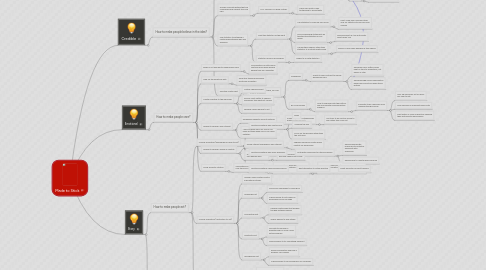
1. Credible
1.1. How to make people believe in the idea?
1.1.1. Create associations
1.1.1.1. Internal credibility
1.1.1.1.1. Personal experience
1.1.1.2. External credibility
1.1.1.2.1. Faith
1.1.1.2.2. Family
1.1.1.2.3. Recommendations from people we want to be
1.1.2. Provide concrete details that are compelling and support the core idea
1.1.2.1. Mrs. Johnson is a good mother
1.1.2.1.1. Child uses Darth Vader toothbrush to brush teeth
1.1.3. Use statistics to establish a relationship between idea and audience
1.1.3.1. Treat the statistics as the input
1.1.3.1.1. Use statistics to make up your mind
1.1.3.1.2. Avoid misleading statements by twisting the statistics in your favour
1.1.3.1.3. Use another medium other than statistics to illustrate relationship
1.1.3.2. Statistics enforce boundaries
1.1.3.2.1. Harder to lie with statistics
1.1.4. Pass the Sinatra Test
1.1.4.1. "If you can make it there, you can make it anywhere"
1.1.4.1.1. Safexpress
1.1.4.1.2. Bill McDonough
2. Emotional
2.1. How to make people care?
2.1.1. Belief is not enough to make people care
2.1.1.1. Consumption of fatty foods continue even when people believe they are unhealthy
2.1.2. Take off the analytical hats
2.1.2.1. Analytical thinking decreases emotional reception
2.1.3. Create empathy to the individual
2.1.3.1. Mother Theresa effect
2.1.3.2. Donors react better to specific individuals than abstract causes
2.1.3.3. Feelings inspire people to act
2.1.4. Appeal to people's self-interest
2.1.4.1. Emphasize benefits and not features
2.1.4.1.1. Audience imagines themselves enjoying the benefits
2.1.4.2. "They laughed when we wrote this book but they woke up in a ice-filled bathtub"
2.1.5. Appeal to people's sense of identity
2.1.5.1. Group interest overwhelms self-interest
2.1.5.1.1. Pegasus dining hall create group identity for employees
2.1.5.2. Groups are based what you identify with
2.1.5.2.1. Bubba cares about littering because Texans don't litter
2.1.6. Avoid semantic stretch
2.1.6.1. Associations become overused over time and diluted in value
2.1.6.1.1. Evolves into an arms race where new emotional associations have to be established
3. Story
3.1. How to make people act?
3.1.1. Provide simulation (knowledge on how to act)
3.1.1.1. Mental simulations help control fear
3.1.1.1.1. Relax
3.1.1.1.2. Visualize the fear
3.1.1.1.3. Focus on the process rather than the outcome
3.1.1.2. Mental simulations help solve problems
3.1.1.2.1. Anticipate responses to future problems
3.1.1.3. Mental simulations improve performance
3.1.1.3.1. Best alternative to actual practice
3.1.2. Provide inspiration (motivation to act)
3.1.2.1. Chicken Soup contain mostly inspirational stories
3.1.2.2. Challenge Plot
3.1.2.2.1. Overcome challenges to reach goal
3.1.2.2.2. Inspire people to act based on perseverance and courage
3.1.2.3. Connecting Plot
3.1.2.3.1. Develop relationship that bridges the gap between people
3.1.2.3.2. Inspire people to help others
3.1.2.4. Creativity Plot
3.1.2.4.1. Innovate to discover a breakthrough or solve a long lasting problem
3.1.2.4.2. Inspire people to try something different
3.1.2.5. Springboard Plot
3.1.2.5.1. Reveal possibilities and how a problem can change
3.1.2.5.2. Inspire people to solve problems for ourselves
3.1.3. Recognize the potential of a sticky idea and the impact of it
3.1.3.1. Jared's Subway Diet
3.1.3.1.1. Audience is simulated imagine what the diet looks like and the outcome
3.1.3.1.2. Audience is inspired to keep trying to diet since Jared was able to lose 245 pounds
3.1.3.2. It is more important to be able to spot ideas than to create them
3.2. Why tell stories?
3.2.1. Bring an element of entertainment along with an element of information
3.2.1.1. Children are looking for entertainment in stories
3.2.2. Engage with the audience
3.2.2.1. Allows the audience to participate along with your presentation instead of thinking about the faults in your argument
